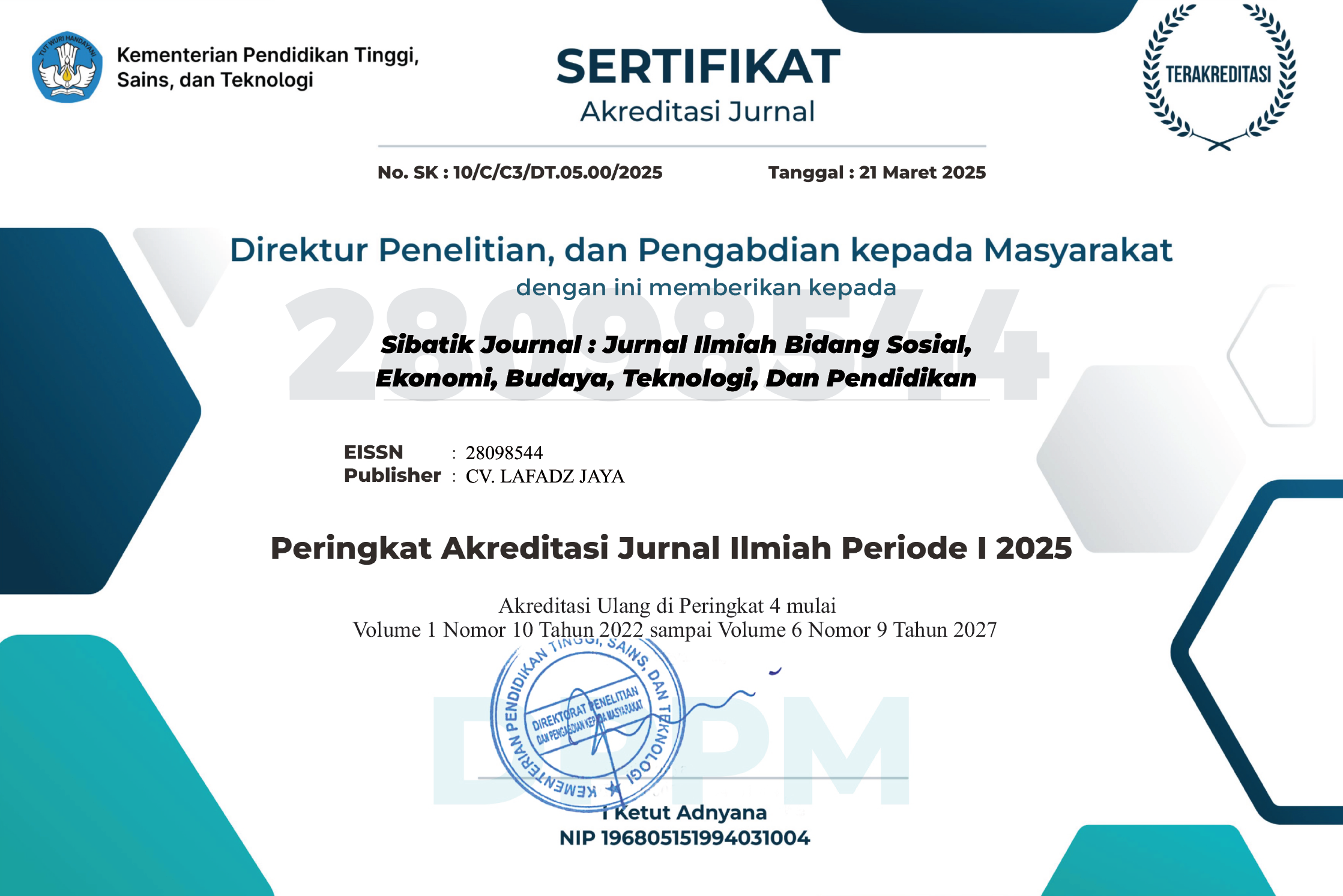INTEGRASI STRATEGI KOMPETITIF DAN KOOPERATIF DALAM EKOSISTEM BISNIS GLOBAL: SEBUAH PERSPEKTIF BARU
Main Article Content
Ken Sabardiman
Amirul Mustofa
Eddy Yunus
The traditional distinction between competitive and cooperative strategies is becoming less relevant in today’s complex and dynamic global business environment. This article offers a new perspective by integrating both approaches through the concept of coopetition—a combination of collaboration and competition—as an adaptive and sustainable strategy. Drawing on a literature review and conceptual analysis, the study examines how firms can simultaneously cooperate and compete within the global business ecosystem, considering contextual factors such as the growth of emerging economies, political dominance, technological disruption, and social demands. The findings indicate that a well-balanced application of coopetition can enhance innovation, share risks, optimize resources, and strengthen long-term competitive advantage. This study contributes to the theoretical development of strategic management and provides practical guidance for business practitioners in designing strategies that are responsive to global environmental changes.
Aladag, D. (2013). Network Coopetition: An Empirical Analysis with Multiple Case Approach. In Dissertation in International Business and Emerging Markets. University of Edinburgh.
Anand, J., & Kale, P. (2006). International joint ventures in emerging economics: Past drivers and emerging trends. In O. Shenkar, & J. Reuer, Handbook of Strategic Alliances (pp. 297-311). Sage: Thousand Oaks, CA.
Barbieri, P., Ciabuschi, F., Fratocchi, L., & Vignoli, M. (2018). What do we now about manufacturing reshoring? Journal of Global Operations and Strategic Sourcing Vol. 11 (1). p. 79-122.
Barney, J. (1991). Firm Resources and Sustained Competitive Advantage. Journal of Management Vol. 17 (1). p. 99-120.
Beamish, P. A. (2016). Cooperative strategies in international business and management: reflection on the past 50 years and future directions. Journal of World Business Vol 51 (1). p. 163-175.
Bengtsson, M., & Kock, S. (2000). Coopetition in business networks-to cooperate and compete simultaneously. Industrial Marketing Management Vol. 29 (5). p. 411-126.
Besanko, D., Dranove, D., Shanley, M., & Schaefer, S. (2009). Economics of Strategy. New York: John Wiley .
Bitektine, A., & Haack, P. (2015). The macro and the micro of legitimacy: toward a multilevel theory of the legitimacy process. Academy of Management Review Vol. 40 (1). p. 49-75.
Boudreau, K., & Lakhani, K. (2013). Using the crowd as an innovation partner. Harvard Business Review Vol. 91 (4). p. 60-69.
Bouncken, R., & Fredrich, V. (2012). Coopetition: performance implications and management antecedents. International Journal of Innovation Management Vol. 16 (5). p. 12500281-1250028.
Bridoux, F.; Coeuderoy, R.; Durand, R. (2011). Heterogeneous motives and the collective creation of value. Academy of Management Review Vol. 34 (11). p. 711-730.
Cennamo, C., & Santalo, J. (2013). Platform competition: strategic trade-offs in platform markets. Strategic Management Journal Vol. 34 (11). p. 1331-1350.
Chen, M., Su, K., & Tsai, W. (2007). Competitive tension: the awareness-motivation-capability perspective. Academy of Management Journal Vol. 50. p. 101-118.
Child, J., & Marinova, S. (2014). The role of contextual combinations in the globalization of Chinese firms. Management and Organization Review. p. 347-371.
Child, J., Faulkner, D., Tallman, S., & Hsieh, L. (2019). Cooperative Strategy 3rd ed. UK: Oxford University Press.
Child, J., Tse, K., & Rodrigues, S. (2013). The Dynamics of Corporate Co-Evolution. Cheltenham, UK: Edward Elgar.
Christensen, C. (1997). The Innovator's Dilemma: When New Technologies Cause Great Firms to Fail. Boston, MA: Harvard Business Review Press.
Coase, R. (1991). The nature of the firm (1937). In The Nature of the Firm: Origins, Evolution, and Development, Williamson OE, Winter SJ (eds). New York: Oxford University Press.
Contactor, F., & Lorange, P. (1988). Why should firms cooperate? The strategy and economics basis for cooperative ventures. In Cooperation Strategies Business. New York: Lexington Books.
Contractor, F., & Reuer, J. (2019). Frontiers of alliance research. In F. Contractor, & J. Reuer, Frontiers of Strategic Alliance Research: Negotiating, Structuring, and Governing Partnerships (pp. 3-39). Cambridge, MA: Cambridge University Press.
Doh, J., Rodrigues, S., Saka, H., & Makhija, M. (2017). International business responses to institutional voids . Journal of International Business Studies Vol. 48 (3). p. 293-307.
Dorn, S., Schweiger, B., & Albers, S. (2016). Levels, phases, and themes of coopetition: a systematic literature review and research agenda. European Management Journal Vol. 34 (5). p. 484-500.
Dorobantu, S., Kaul, A., & Zelner, B. (2017). Nonmarket strategy research through the lens of new institutional economics: an integrative review and future directions. Strategic Management Journal Vol. 38 (1). p. 114-140.
Durand, R., Grant, R., & Madsen, T. (2017). The expanding domain of strategic management research and the quest for integration. Strategic Management Journal Vol. 38. p. 4-16.
Durand, R., Paugam, L., & Stolowy, H. (2019). Do investors actually value sustainability indices? Replication, development, and new evidence on CSR visibility. Strategic Management Journal Vol. 40 (9). p. 1471-1490.
Dussauge, P. a. (1999). Cooperative Strategy: Competing Successfully through Strategic Alliances. Chichester, UK: John Wiley.
Dyer, J. (1996). Specialized Supplier Networks as a Source of Competitive advantage: Evidence from the auto industry. Strategic Management Journal.
Dyer, J. (1997). Effective interim collaboration: how firms minimize transactions costs and maximize transaction value. Strategic Management Journal Vol. 18 (7). p. 535-556.
Eisenhardt, K., & Martin, J. (2000). Dynamic capabilities: what are they? Strategic Management Journal. p. 1105-1121.
Gartenberg, C., Prat, A., & Serafeim, G. (2019). Corporate purpose and financial performance. Organization Science Vol. 30 (1). p. 1-18.
Georgallis, P., Dowell, G., & Durand, R. (2019). Shine on me: industry coherence and policy support for emerging industries. Administrative Science Quarterly Vol. 64 (3). p. 503-541.
Goodall, W., Fishman, T., Bornstein, J., & Bonthron, B. (2017). The rise of mobility as a service: reshaphing how urbanites get around. Deloitte Review Vol. 20. p. 113-129.
Granata, J. (12-15 Juni 2013). The Multiplication of Coopetitive Strategies in South of France Wine Industry. 7th AWBR International Conference.
Han, J., Shipilov, A., & Greve, H. (2017). Unequal bedfellows: gender role-based deference in multiplex ties between Korean business groups. Academy of Management Journal Vol. 60 (4). p. 1531-1553.
Helfat, C., & Peteraf, M. (2015). Managerial cognitive capabilities and the microfoundations of dynamic capabilities. Strategic Management Journal Vol. 36 (6). p. 831-850.
Hennart, J. (1988). A transaction costs theory of equity joint ventures. Strategic Management Journal Vol. 9 (4). p. 361-374.
Hoffmann, W., Lavie, D., Reuer, J., & Shipilov, A. (2018). The interplay of competition and cooperation. Strategic Management Journal Vol. 39 (12). p. 3033-3052.
Hoopes, D., Madsen, T., & Walker, G. (2003). Guest editor's introduction to the special issue: why is there a resource-based view? Toward a theory of competitive heterogeneity. Strategic Management Journal Vol. 24 (10). p. 889-902.
Jacobides, M., Cennamo, C., & Gawer, A. (2018). Towards a theory of ecosystems. Strategic Management Journal Vol. 39 (8). p. 2255-2276.
Juasrikul, S., Sahaym, A., Hyunsoon, Y., & Liu, R. (2018). Do Cross-border alliances with MNEs from developed economics create firm value for MNEs from emerging economies? Journal of Business Research. p. 98-110.
Judge, W., & Dooley, R. (2006). Strategic alliance outcomes: a transaction-cost economics perspective. British Journal of Management Vol. 17 (1). p. 23-37.
Khanna, T., & Palepu, K. (2000). The future of business groups in emerging markets: long-run evidence from Chile. Academy of Management Journal Vol. 43 (3). p. 268-285.
Klijn, E., Reuer, J., Buckley, P., & Glaister, K. (2010). Combinations of partner's join venture formation motives. European Business Review Vol. 22 (6). p. 576-590.
KPMG. (2017). Strategic Alliances: A Real Alternative to M&A. KPMG International.
Laursen, K., & Salter, A. (2006). Open of innovation: the role of openness in explaining innivation performance among UK manufacturing firms. Strategic Management Journal Vol. 27 (2). p. 131-150.
Leonardi, P., & Barley, S. (2010). What's under construction here? Social action materiality, and power in constructivist studies technology and organizing. Academy of Management Annals Vol. 4 (1). p. 1-51.
Mc Williams, A., & Siegel, D. (2000). Corporate social responsibility and financial performance: correlation or misspecification? Strategic Management Journal Vol. 21 (5). p. 603-609.
Meyer, K., & Grosse, R. (2019). Introduction to managing in emerging markets. In K. Meyer, & R. Gosse, Oxford Handbook of Managing in Emerging Markets (pp. 3-34). New York: Oxford University Press.
Nalebuff, B., & Brandenburger, A. (1996). Co-opetition. London UK: Harper Collins Business.
Nelson, R. (1991). Why do firms differ, and how does it matter? Strategic Management Journal Vol. 12 (S2). p. 61-74.
Penrose, E. (1959). The Theory of the Growth of the Firm. Oxford, UK: Blackwell.
Petricevic, O., & Teece, D. (2019). The structural reshaphing of globalization: implications for strategic sector, profiting from innovation, and the multinational enterprise. Journal of International Business Studies Vol. 50 (9). p. 1487-1512.
Poppo, L., & Zenger, T. (1998). Testing alternative theories of the firm: transaction cost, knowledge based, and measurement explanations for make-or-buy decisions in information services. Strategic Management Journal Vol. 19 (9). p. 853-877.
Porter, M. (1980). Competitive Strategy: Techniques for Analyzing Industries and Competitors. New York: Free Press.
Porter, M. (1985). The Competitive Advantage: Creating and Sustaining Superior Performance. New York: Free Press.
Powell, T. (2001). Competitive advantage: logical and philosophical considerations. Strategic Management Journal Vol 22 (9). p. 857-888.
Powell, T., Lovallo, D., & Fox, C. (2011). Bahavioral strategi. Strategic Management Journal Vol. 32 (13). p. 1369-1386.
Quenlin, B., Cabral, S., Lazzarini, S., & Kivleniece, I. (2019). The private scope in public-private collaborations: an institutional and capability-based perspective. Organization Science Vol. 30 (4). p. 831-846.
Ritala, P. (2012). Coopetition strategy-when is it succesful? Empirical evidence on innovation and market performance. British Journal of Management Vol. 23 (3). p. 307-324.
Ritala, P., Golnamm, A., & Wegmann, A. (2014). Coopetitive-based business models: The Case of Amazon.com. Industrial Marketing Management Journal. (Vol 43 (2). p. 236-249.
Rosenkopf, L., & Nerkar, A. (2001). Beyond local search: boundary-spanning, exploration, and impact in the optical disk industry. Strategic Management Journal Vol. 22 (4). p. 287-306.
Schad, J., Lewis, M., Raisch, S., & Smith, W. (2016). Paradox research in management science: looking back to move forward . Academy of Management Annals Vol. 10 (1). p. 5-64.
Siregar, S. L. (2006). Koopetisi Industri Perbankan di Indonesia. Prosiding Seminar Nasional Manajemen Teknologi IV. Surabaya.
Surroca, J., Tribo, J., & Waddock, S. (2010). Corporate responsibility and financial performance: the role of intangible resources. Strategic Management Journal Vol. 31 (5). p. 463-490.
Tallman, S., & Shenkar, O. (1994). managerial decision model of international cooperative venture formation. Journal of International Business Studies Vol. 25 (1). p. 91-113.
Tantalo, C., & Priem, R. (2016). Value creation through stakeholder synergy. Strategic Management Journal Vol. 37 (2). p. 314-329.
Umar, H. (2008). Management In Strategic Action. Jakarta: PT Gramedia Pustaka Utama.
Vasi, I., & King, B. (2012). Social movements, risk perceptions, and economic outcomes: the effect of primary and secondary stakeholder activism on firm's perceived environmental risk and financial performance. American Sociological Review. p. 573-596.
Wernerfelt, B. (1984). A resource-based view of the firm. Strategic Management Journal Vol. 5 (2). p. 171-180.
Williamson, O. (1981). The economics of organization: the transaction cost approach. American Journal of Sociology Vo. 87 (3). p. 548-577.
Williamson, O. (1985). The Economic Institutions of Capitalism. New York: Free Press.
Xu, D., & Meyer, K. (2013). Linking theory and context: "strategy research in emerging economies" after Wright et al 2005. Journal of Management Studies Vol. 50 (7). p. 1322-1346.

























